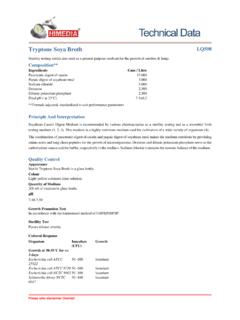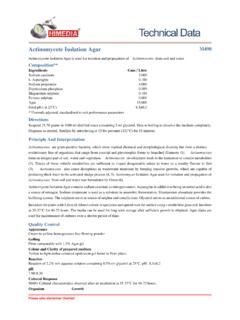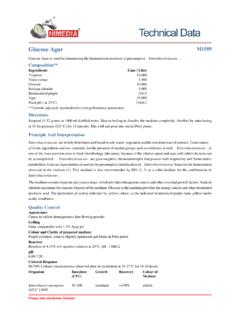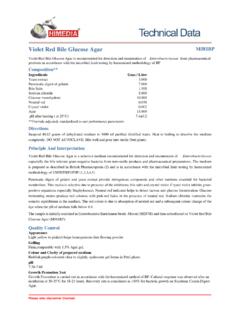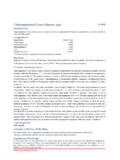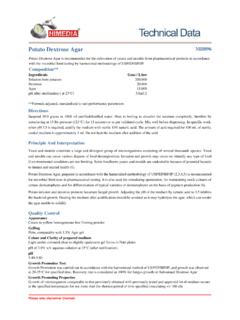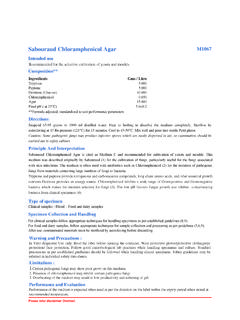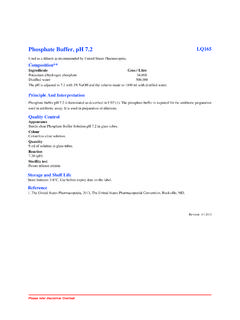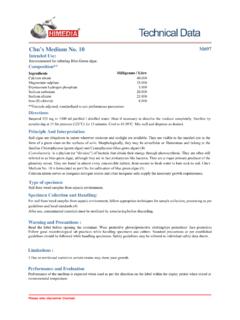Transcription of Soyabean Casein Digest Agar (Tryptone Soya Agar) M2 ...
1 Please refer disclaimer Casein Digest agar ( tryptone soya Agar) M290 ( Casein Soyabean Digest Agar) Intended useSoyabean Casein Digest agar is a general purpose medium used for cultivation of a wide variety of microorganisms from clinical and non-clinical samples and for sterility testing in pharmaceutical **IngredientsGms / LitreTryptone # pH ( at 25 C) **Formula adjusted, standardized to suit performance parametersDirectionsSuspend 40 grams in 1000 ml purified/distilled water. Heat to boiling to dissolve the medium completely. Sterilize by autoclaving at 15 lbs pressure (121 C) for 15 minutes. If desired, aseptically add 5% v/v defibrinated blood in previously cooled medium to 45-50 C for cultivation.
2 Mix well and pour into sterile Petri And InterpretationSoyabean Casein Digest agar is a widely used medium, which supports the growth of wide variety of organisms even that of fastidious ones such as Neisseria, Listeria , and Brucella etc. The medium with addition of blood provides perfectly defined haemolysis zones, while preventing the lysis of erythrocytes due to its sodium chloride content. It has been frequently used in the health industry to produce antigens, toxins etc. It's simple and inhibitor-free composition makes it suitable for the detection of antimicrobial agents in the food and other products. tryptone soya agar is recommended by various pharmacopoeias as sterility testing medium (6, 3).
3 tryptone soya agar conforms as per USP (6) and is used in microbial limit test and antimicrobial preservative - effective test. Gunn et al (2) used this medium for the growth of fastidious organisms and study of haemolytic reaction after addition of 5%v/v blood. The combination of tryptone and soya peptone makes this media nutritious by providing amino acids and long chain peptides for the growth of microorganisms. Sodium chloride maintains the osmotic Casein Digest agar does not contains X and V growth factors. It can be conveniently used in determining the requirements of these growth factors by isolates of Haemophilus by the addition of X-factor (DD020), V-factor (DD021), and X+V factor discs (DD022) factor to inoculated TSA plates (1).
4 Type of specimen Pharmaceutical samples, Clinical samples- blood and other body fluidsFor clinical samples follow appropriate techniques for handling specimens as per established guidelines (4,5).For Pharmaceutical samples follow appropriate techniques for sample collection, handling and processing as per pharmacopeias. After use, contaminated materials must be sterilized by autoclaving before discarding. Specimen Collection and Handling: # Equivalent to Pancreatic Digest of caseinWarning and PrecautionsIn Vitro diagnostic Use. Read the label before opening the container. Wear protective gloves/protective clothing/eye protection/ face protection. Follow good microbiological lab practices while handling specimens and culture.
5 Standard precautions as per established guidelines should be followed while handling clinical specimens. Safety guidelines may be referred in individual safety data DataPlease refer disclaimer Laboratories Limitations medium is general purpose medium and may not support the growth of fastidious ControlAppearanceCream to yellow homogeneous free flowing powderGellingFirm, comparable with agar gelColour and Clarity of prepared mediumBasal Medium : Light yellow coloured clear to slightly opalescent gel. After addition of 5-7%w/v sterile defibrinated blood : Cherry red coloured opaque gel forms in Petri platespH of w/v aqueous solution at 25 C.
6 And EvaluationPerformance of the medium is expected when used as per the direction on the label within the expiry period when stored at recommended (CFU)Observed Lotvalue (CFU)RecoveryObserved Lotvalue (CFU)w/bloodRecovery w/bloodHaemolysisBacillus subtilis subsp. spizizenii ATCC 6633 (00003)*50 -10035 -100>=70 %35 -100>=70 %noneStaphylococcus aureus subsp. aureus ATCC 25923 (00034)*50 -10035 -100>=70 %35 -100>=70%betaStaphylococcus aureus subsp. aureus ATCC 6538 (00032)*50 -10035 -100>=70 %35 -100>=70 %betaCultural responseCultural characteristics was observed after an incubation for Bacterial at 30-35 C 18-24 hours and for Fungal at 30-35 C<= coli ATCC 25922 (00013)*50 -10035 -100>=70 %35 -100>=70 %Escherichia coli ATCC 873950 -10035 -100>=70 %35 -100>=70 %Escherichia coli NCTC 900250 -10035 -100>=70 %35 -100>=70 %Pseudomonas aeruginosa ATCC 27853 (00025)*50 -10035 -100>=70 %35 -100 Pseudomonas aeruginosa ATCC 9027 (00026)*50 -10035 -100>=70 %35 -100 Salmonella Abony NCTC 6017 (00029)*50 -10035 -100>=70 %35 -100>=70 %>=70 %>=70 %nonenonenone---(00012)*Escherichia coli ATCC 11775 (00090)
7 *50 -10035 -100>=70 %35 -100>=70 %noneEscherichia coli NCTC 13167 (00179)*50 -10035 -100>=70 %35 -100>=70 %nonePseudomonas aeruginosa ATCC 10145 (00024)*50 -10035 -100>=70 %35 -100>=70 %-Micrococcus luteus ATCC934150 -10035 -100>=70 %35 -100>=70 %-Streptococcus pneumoniaeATCC 630550 -10035 -100>=70 %35 -100>=70 %-Please refer disclaimer LaboratoriesTechnical DataStorage and Shelf LifeStore between 10-30 C in a tightly closed container and the prepared medium at 20-30 C. Use before expiry date on the label. On opening, product should be properly stored dry, after tightly capping the bottle inorder to prevent lump formation due to the hygroscopic nature of the product.
8 Improper storage of the product may lead to lump formation. Store in dry ventilated area protected from extremes of temperature and sources of ignition Seal the container tightly after use. Use before expiry date on the performance is best if used within stated expiry period. Candida albicans ATCC 10231 (00054)*50 -10035 -100>=70 %35 -100 Candida albicans ATCC 2091 (00055)*50 -10035 -100>=70 %35 -100# Aspergillus brasiliensis ATCC 16404 (00053)*50 -10025 -7050-70%>=70 %>=70 %---Enterococcus faecalis ATCC 29212 (00087)*50 -10035 -100>=70 %35 -100>=70 %-Clostridium perfringenes ATCC 13124 (00007)*50 -10035 -100>=70 %35 -100>=70 %-Key : (#)- Formerly known as Aspergillus niger (*) - Corresponding WDCM numbersSalmonella Typhimurium ATCC 14028 (00031)*50 -10035 -100>=70 %35 -100>=70 %-User must ensure safe disposal by autoclaving and/or incineration of used or unusable preparations of this product.
9 Follow established laboratory procedures in disposing of infectious materials and material that comes into contact with clinical sample must be decontaminated and disposed of in accordance with current laboratory techniques (4,5). DisposalReference6. The United States Pharmacopoeia , 2019, The United States Pharmacopoeial Convention Inc., Rockville, Indian Pharmacopoeia, 2018, Govt. of India, Ministry of Health and Family Welfare, New Delhi, Gunn B. A., Ohashi D K., Gaydos C. A., Holt E. S., 1977, J. Clin. Microbiol., 5(6) : Forbes B. A., Sahm A. S. and Weissfeld D. F., 1998, Bailey and Scotts Diagnostic Microbiology, 10th Ed., Mosby Louis, , Clinical Microbiology Procedures Handbook.
10 2nd , , Pfaller, , Carroll, , Funke, G., Landry, , Richter, and Warnock., (2015)Manual of Clinical Microbiology, 11th Edition. Vol. : 02/ 2018 HiMedia LaboratoriesTechnical DataDisclaimer :User must ensure suitability of the product(s) in their application prior to use. Products conform solely to the information contained inthis and other related HiMedia publications. The information contained in this publication is based on our research and developmentwork and is to the best of our knowledge true and accurate. HiMedia Laboratories Pvt Ltd reserves the right to make changes tospecifications and information related to the products at any time.
